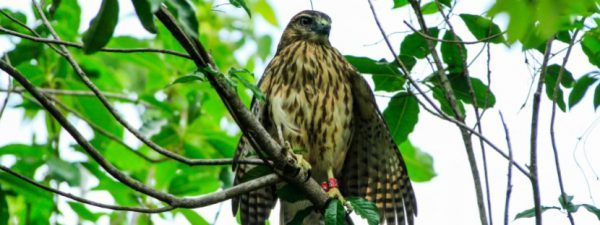
There are two critically endangered species of birds in the Dominican Republic: Ridgeway’s hawk (Buteo ridgwayi) and the bay-breasted cuckoo (Coccytus rufigularis). Of these two the hawk had been losing its habitat in Los Haitises, where farmers killed as many as possible out of misguided beliefs that the hawks preyed on their chickens.
For years, the Puntacana Group’s Puntacana Foundation has backed efforts to create a safe haven for the majestic birds in the area. Together with the Peregrine Foundation Fund, quite a successful program of relocation, protection and fostering of the hawk population has been underway.
At a time when upwards of 50,000 hotel rooms in the Punta Cana area are closed, efforts continue to save the hawks. Just last week, members of the teams were able to band several examples of the hawks to monitor their hunting and mating patterns. An update in Diario Libre looks into advances of the program. According to Jake Kheel, the program also includes educational programs that reach out to the humblest populations still living in Los Haitises and the areas surrounding Punta Cana, to teach people about the benefits of these hawks and their importance to the ecosystem.
Most small farmers have an outlandish fear of the hawks, not knowing that 90% of the hawk’s preferred dietary menus are reptiles and rodents and not chickens. However, the hawks are carnivores and will eat small mammals and birds.
Kheel explained to reporters that back in 2009, the foundation decided that the fastest way to help re-establish a population of Ridgeway hawks was to relocate some of them. The ideal place was Puntacana Resort & Club, where there is no farming and tourism is the mainstay of economic activity. The abundant palm trees became the favorite nesting place for the initial three birds, taken as mere hatchlings from Los Haitises.
This was the start, and the foundation built an observatory to study the birds and follow their development. Each year, more and more hatchlings were taken to Punta Cana and in time, they formed pairs and began to reproduce on the club grounds. Over the past eleven years, the grounds of the resort, known for its white-sand beaches and great golf courses, has become the habitat of the second largest population of Ridgeway’s hawks on the island of Hispaniola. There are now between 100 and 150 birds on the grounds and surrounding forests of the area.
As of this writing, there were 18 nesting pairs with 30 eggs and, so far, 13 hatchlings. Hawks might hatch two or three eggs, but generally speaking only one or two will survive. Also called the Hispaniola hawk, this cousin of the “guaraguao”, the beautiful red-tailed hawk native to the Antilles, and also on the endangered list, is increasing its population. Birds have been re-introduced to the region of Aniana Vargas in the province of Monsignor Nouel (Bonao). And, for the first time in 50 years three hawks were sighted in the tiny islands called Les Cayemites in Haiti. Reports had been that the birds had disappeared from Haiti.
Read more:
Diario Libre
Grupo Puntacana
Globalgiving
Peregrinefund
27 April 2020

